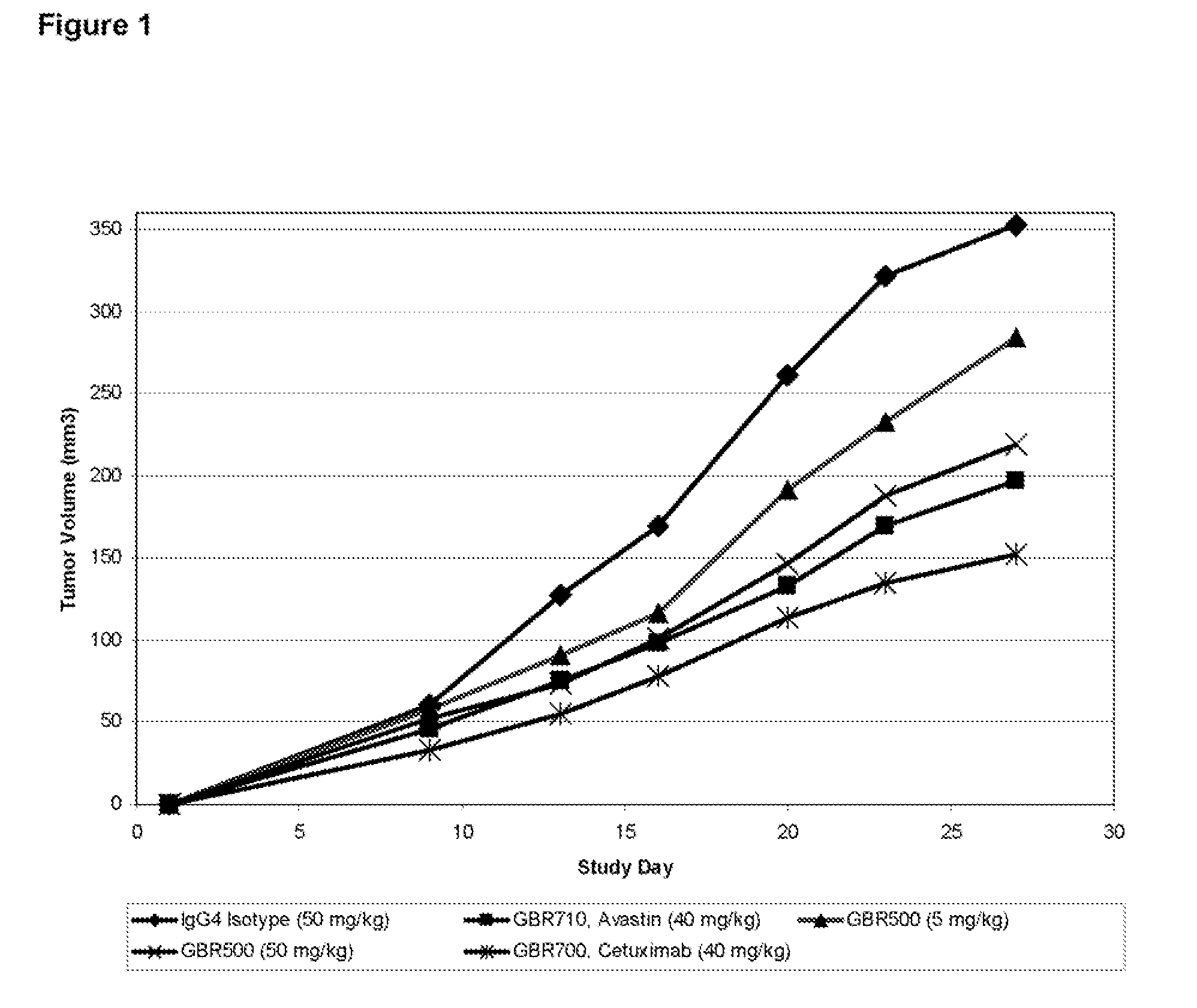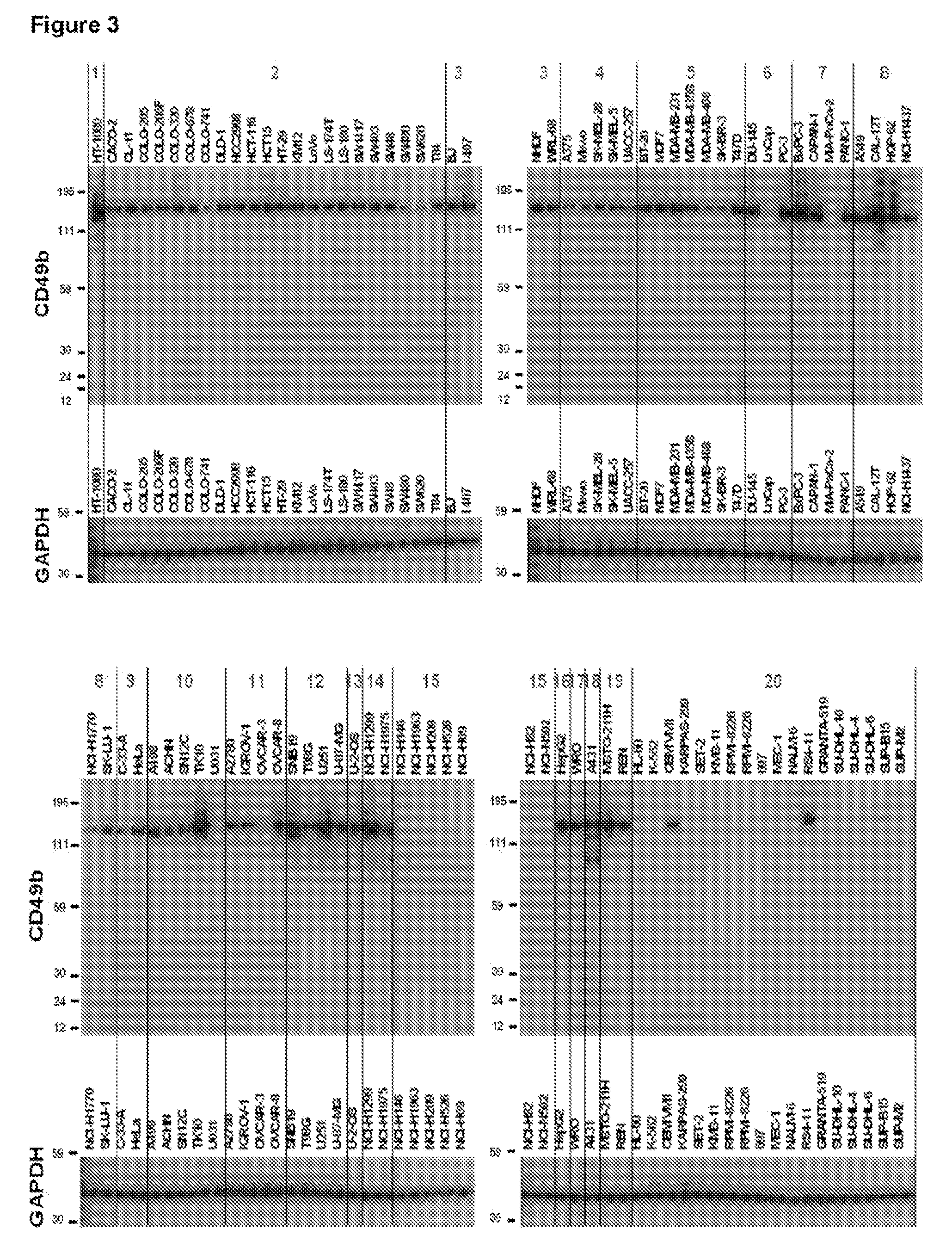Treatment with Anti-alpha2 integrin antibodies
a technology of anti-alpha2 integrin and anti-alpha2, which is applied in the field of cancer treatment, can solve the problems of limited use of murine monoclonal antibodies, such as those described above, as human therapeutic agents in non-immunocompromised patients, loss of potentially desirable complement activation and antibody-dependent, cell-mediated cytotoxicity (adcc) activity, etc., and achieve the effect of blocking 2-dependent adhesion
- Summary
- Abstract
- Description
- Claims
- Application Information
AI Technical Summary
Benefits of technology
Problems solved by technology
Method used
Image
Examples
example 1
In Vitro Evaluation of Anti-α2 Integrin Antibody Potencies in Inhibiting Interaction Between Human α2 Integrin Expressed on Human Carcinoma Cell Lines and Human Collagen
[0192]An in vitro binding assay between human cell line and human collagen has been established to assess the potency of different anti-α2 integrin antibodies to inhibit the interaction between human VLA-2 (α2β1) integrin expressed on human carcinoma cell lines and human collagen type I. In this assay, fluorescently labelled human pancreatic cancer cell lines that naturally expresses VLA-2 were distributed in 96 well plates which have been previously coated with human collagen type I. A fluorescently labelled human pancreatic cancer cell line that doesn't express VLA-2 was used as a negative control. Fluorescently-labelled cells were then incubated in the collagen coated 96 well plates in presence of different concentrations of the anti-α2 integrin (GBR500 or TMC2206) or isotype-matched control antibody (GBR600) for ...
example 2
Effect of GBR500 Against the Human Pancreatic Carcinoma Tumour Xenograft AsPC-1 in BALB / c Nude (nu / nu) Athymic Mice
[0202]Female BALB / c nude (nu / nu) athymic mice, of at least 6-8 weeks age were used in the xenograft study. Animals obtained from Australian Research Council (ARC) were assigned into treatment groups on day −2 of the study and treatment was being started as per the regime described in Table 6. On day 1 human AsPC-1 pancreatic carcinoma tumour cells (ATCC® Number: CRL-1682) were harvested from sub-confluent cultures grown in vitro and the number of viable cells determined. Cells were re-suspended in 1×PBS at a concentration of 5×107 cells / ml and animals were injected subcutaneously in the rear right flank with approximately 5×106 cells in a volume of 0.1 ml.
[0203]Animals were examined regularly for the appearance of tumours and dosed biweekly for 22 days starting from day −2 (Total 7 injections on days −2, 2, 6, 9, 13, 16, 20). Antibodies were administered in a volume of ...
example 3
Effect of GBR500 Against the HT29 Human Colon Carcinoma Xenograft in nu / nu Athymic Mice
[0205]Nu / Nu male mice, from Harlan, Italy, were used. The animals were maintained in cages using steam autoclaved (sterile) bedding, diet and water were offered ad libitum. Animals were identified by a uniquely numbered ear-tag which appears on the data sheets. Body weight at the day of tumor implantation was: 24-31 g.
Number of Groups-Treatment Schedule:
[0206]Number of groups was 5. Number of animals / group was 10. Treatment was being started as per the regime described in Table 7.
TABLE 7Treatment Groups and Study DesignDoseGroupCompoundmg / kgRoute / Schedule1IgG4 Isotype50IP*Day 6, 9, 13, 16, 20, 23, 27**2Ha1 / 29 5IPDay 6, 9, 13, 16, 20, 23, 27**3GBR50050IPDay 6, 9, 13, 16, 20, 23, 27**4Ha1 / 29 +50 + 5IPDay 6, 9, 13, 16, 20, 23, 27**GBR5005Avastin ®40IPDay 6, 9, 13, 16, 20, 23, 27***IP: intraperitoneally**Treatment starts at day 6 after tumor implants
Substances:
[0207]Test compounds were stored at 4° C....
PUM
 Login to View More
Login to View More Abstract
Description
Claims
Application Information
 Login to View More
Login to View More - R&D
- Intellectual Property
- Life Sciences
- Materials
- Tech Scout
- Unparalleled Data Quality
- Higher Quality Content
- 60% Fewer Hallucinations
Browse by: Latest US Patents, China's latest patents, Technical Efficacy Thesaurus, Application Domain, Technology Topic, Popular Technical Reports.
© 2025 PatSnap. All rights reserved.Legal|Privacy policy|Modern Slavery Act Transparency Statement|Sitemap|About US| Contact US: help@patsnap.com



